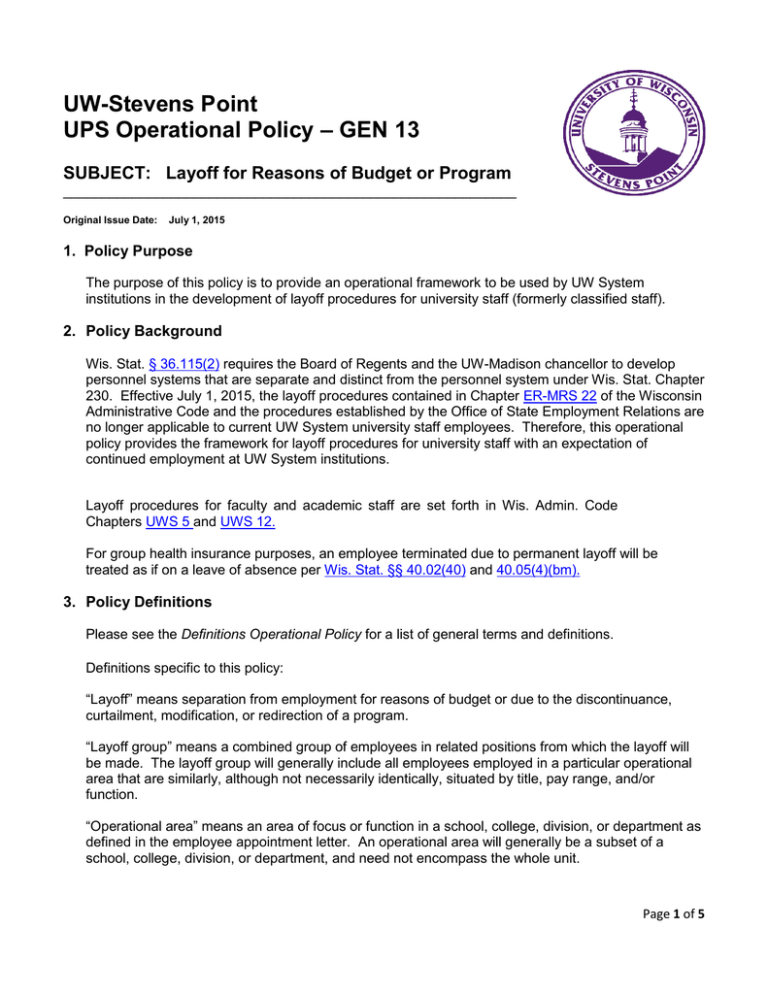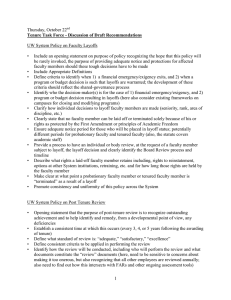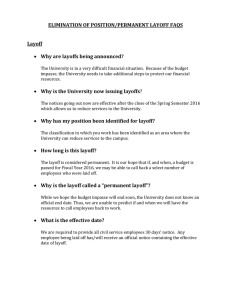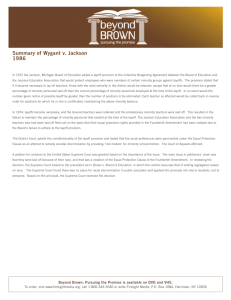UW-Stevens Point – GEN 13 UPS Operational Policy
advertisement

UW-Stevens Point UPS Operational Policy – GEN 13 SUBJECT: Layoff for Reasons of Budget or Program ___________________________________________________________ Original Issue Date: July 1, 2015 1. Policy Purpose The purpose of this policy is to provide an operational framework to be used by UW System institutions in the development of layoff procedures for university staff (formerly classified staff). 2. Policy Background Wis. Stat. § 36.115(2) requires the Board of Regents and the UW-Madison chancellor to develop personnel systems that are separate and distinct from the personnel system under Wis. Stat. Chapter 230. Effective July 1, 2015, the layoff procedures contained in Chapter ER-MRS 22 of the Wisconsin Administrative Code and the procedures established by the Office of State Employment Relations are no longer applicable to current UW System university staff employees. Therefore, this operational policy provides the framework for layoff procedures for university staff with an expectation of continued employment at UW System institutions. Layoff procedures for faculty and academic staff are set forth in Wis. Admin. Code Chapters UWS 5 and UWS 12. For group health insurance purposes, an employee terminated due to permanent layoff will be treated as if on a leave of absence per Wis. Stat. §§ 40.02(40) and 40.05(4)(bm). 3. Policy Definitions Please see the Definitions Operational Policy for a list of general terms and definitions. Definitions specific to this policy: “Layoff” means separation from employment for reasons of budget or due to the discontinuance, curtailment, modification, or redirection of a program. “Layoff group” means a combined group of employees in related positions from which the layoff will be made. The layoff group will generally include all employees employed in a particular operational area that are similarly, although not necessarily identically, situated by title, pay range, and/or function. “Operational area” means an area of focus or function in a school, college, division, or department as defined in the employee appointment letter. An operational area will generally be a subset of a school, college, division, or department, and need not encompass the whole unit. Page 1 of 5 “Probationary period” means the initial period of employment in an appointment during which the employee has no right to appeal discharge as identified in the employee’s appointment letter. “Temporary employment” means employment in a university staff temporary or project appointment. “Temporary layoff” means a layoff for a period not to exceed 20 working days. 4. Policy Institutional layoff procedures shall include the following elements: A. Temporary and Probationary Employment Whenever practicable, employees in temporary or project appointments in the operational area shall be reduced or discontinued before invoking the layoff procedures. Employees in a probationary period may be dismissed prior to laying off non-probationary employees, providing that those remaining employees have the necessary skills, knowledge, and ability to perform the work. B. Layoff Selection and Plan Prior to providing layoff notice to any employees, the Department Head, Director, Dean, or equivalent administrator shall develop a plan under which a layoff will occur. The plan will document: the reason(s) for the layoff the anticipated date of separation (management should consider the total budgetary cost of separating an employee through layoff when determining an appropriate separation date) a listing of all vacant positions in the department which are in the same branch, role and competency level with a status of recruitment activity for those positions what efforts the department made to avoid the layoff of the selected employee(s) a brief explanation why action other than layoff is not possible a management contact This plan will be submitted to Department of Human Resources and Affirmative Action and shared with the University Staff Council Temporary layoffs are not subject to layoff procedures within this policy. Employees subject to layoff will be determined and evaluated by using the following criteria: Needs of institution to deliver services; Relative skills, knowledge, or expertise of employees; Length of service of employees within the UW System; and Other appropriate criteria. Upon an employer’s layoff notification to an employee, the employee may appeal the layoff decision through the appropriate grievance procedures (see Operational Policy GEN 14: Grievance Procedures). Once the layoff group has been determined, any employee from within the affected layoff group may elect to retire or voluntarily be laid off to avoid involuntary layoffs. Page 2 of 5 The employer reserves the right to rescind a layoff notice and/or postpone the layoff date. However, once the employee has been officially notified of the intended layoff date, the employer may not make the layoff date any earlier. C. Notice Full or part-time staff who are employed where layoff is probable will receive written at-risk notification at least 30 calendar days prior to the actual layoff notification. A full or part-time staff member who is designated for layoff must be given written notice as soon as practicable, but not less than 30 calendar days prior to the effective date of the layoff. This written notice will indicate: the reason for the layoff the effective date of the layoff notification that Department of Human Resources and Affirmative Action will contact them to arrange for a layoff information session, including details on the University’s policy on priority re-employment completion of necessary forms the availability of aid in seeking other employment eligibility to apply for unemployment insurance benefits other benefits information for separating employees the right of permanent employees to appeal the layoff through the Grievance Policy At the request of the affected employee, University Staff Council will receive both the at-risk and layoff notices when distributed to employees. At any time during the notification of layoff period and with mutual agreement of the employee and appointing authority, a lateral movement or demotion to a different position within the UW institution may be made outside of a recruitment process. D. Alternatives to Layoff An employee may be moved to another position regardless of being designated in layoff status. The employee shall receive written notice as to why he/she is being moved. Involuntary employee movements are not meant to circumvent the recruitment process and should only be used to avoid a reduction in force. The employee may choose not to accept the involuntary reassignment and as a result be laid off. If the employee accepts the involuntary reassignment, the employee’s rate of pay and applicable benefits will not decrease if the movement is lateral; however, the rate of pay may be adjusted with a downward movement. E. Employee Benefits upon Layoff Employees enrolled in State Group Health Insurance at the time of layoff are eligible to continue coverage under the group plan following the layoff date. The employee’s coverage will continue through the month in which premiums are paid and the employer contribution towards the health insurance premium is paid for an additional three (3) months. The employee must pay his/her share of the health insurance premium during these months to maintain coverage. The employee may pay the premium through payroll deduction, personal check, or converted sick leave credits. Page 3 of 5 UW System employees who terminate due to layoff are eligible for the conversion of their sick leave credits to pay for State Group Health Insurance provided eligibility requirements are met under the Accumulated Sick Leave Conversion Credit (ASLCC) and Supplemental Health Insurance Conversion Credit (SHICC) programs as outlined in Wis. Stat. §§ 40.05(4)(b) and 40.95. Health insurance premiums are paid from sick leave credits until the earliest of the following events: (1) The credits are exhausted; (2) The first of the month following the begin date of other employment offering comparable health insurance coverage; (3) Five (5) years have elapsed from the date of layoff (no time restriction if the employee has over 20 years of WRS creditable service at time of layoff); or (4) The employee dies. If the employee dies, the employee’s surviving spouse/domestic partner and dependents can continue to use remaining sick leave credits to pay for health insurance. Coverage under all other benefit plans ends according to the normal termination rules of the plan. F. Consideration for Vacant Positions within UW System An employee who is or will be affected by a layoff may request, in accordance with the hiring authority’s requirements, to be considered for other vacancies within the UW System. Such consideration does not guarantee an interview or mandatory job offer. Every effort will be made to maintain active positions for employees so long as this effort does not adversely affect the operational area’s budget or impede the area’s ability to fulfill its mission. A laid off employee may apply for vacant positions in the same manner as a current employee for a period of three (3) years from the date of layoff. G. Three-Year Restriction on Rehiring for Duties of Laid Off Employee For three (3) years from the anniversary of the layoff, no person may be employed in a position with an expectation of continued employment in that operational area to perform duties reasonably comparable to the duties of the laid off employee, without first making an offer of return to the laid off employee. An employee’s failure to accept such an offer of return shall terminate the rights under this section. As determined by the appointing authority, an offer of appointment is considered reasonable if it meets all of the following five (5) conditions as of the date of the offer: (1) The position is one that the employee would be qualified to perform after customary orientation provided to new workers in the position. (2) The position is the highest-level position available within the agency to which the Page 4 of 5 employee could either transfer or demote. (3) The work hours required are the same as those previously worked; both in number and shift. (4) The position is located at a worksite that is within reasonable proximity of the original worksite. (5) The pay range of the position offered is no more than three (3) pay ranges/counterpart pay ranges or one (1) broadband pay range lower than the pay range of the position from which the employee was laid off. NOTE: Some positions that meet each of the five conditions above may become unreasonable due to exceptional circumstance. 5. Related Documents UPS Operational Policy GEN 14: Grievance Procedures UPS Operational Policy BN 3: Sick Leave Wis. Admin. Code Chapter UWS 5, Layoff and Termination for Reasons of Financial Emergency Wis. Admin. Code Chapter UWS 12, Layoff of Academic Staff for Reasons of Budget or Program 6. Policy History Wis. Stat. § 230.34, Demotion, suspension, discharge and layoff Wis. Stat. § 230.44(1)(c), Demotion, layoff, suspension or discharge Wis. Admin. Code Chapter ER-MRS 22, Layoff procedure Approved: ______________________________________________ Bernie Patterson, Chancellor University of Wisconsin-Stevens Point _________________ Date Page 5 of 5


